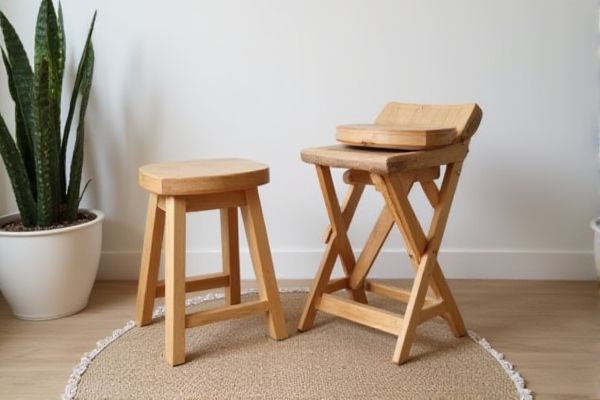
Stackable stools maximize space efficiency by allowing multiple stools to be securely stacked on top of each other, making them ideal for permanent or semi-permanent seating arrangements. Folding stools offer unparalleled portability and quick storage options, perfect for your on-the-go needs or temporary seating solutions; explore the rest of the article to find out which option suits your lifestyle best.
Table of Comparison
| Feature | Stackable Stool | Folding Stool |
|---|---|---|
| Design | Rigid frame, designed to stack vertically | Hinged frame, designed to fold flat |
| Storage | Compact stacking saves floor space | Folds flat, ideal for limited storage |
| Portability | Less portable due to rigid structure | Highly portable and lightweight |
| Setup | Ready to use without assembly | Requires unfolding before use |
| Durability | Typically more stable and durable | May wear on hinges over time |
| Weight Capacity | Generally higher load capacity | Moderate load capacity depending on design |
| Use Cases | Ideal for fixed seating in cafes, events | Perfect for camping, outdoor activities |
Introduction to Stackable and Folding Stools
Stackable stools offer space-saving convenience by allowing multiple stools to be neatly piled for easy storage, making them ideal for environments with limited space. Folding stools provide portability and quick setup, featuring collapsible frames that make them perfect for outdoor events or temporary seating. Your choice depends on whether you prioritize compact storage or maximum mobility.
Design and Construction Differences
Stackable stools feature a rigid frame designed for stable vertical stacking, often crafted from durable materials like metal or hardwood, enabling efficient storage in limited spaces. Folding stools incorporate hinges and lightweight materials such as aluminum or plastic, allowing the seat and legs to collapse flat for compact portability and easy transport. The contrasting designs prioritize stable stacking in fixed seating arrangements versus flexible, space-saving solutions for mobile or temporary use.
Space-Saving Capabilities
Stackable stools maximize space efficiency by allowing multiple units to be neatly piled, ideal for compact storage in small rooms or busy venues. Folding stools collapse flat, providing even more flexible storage options for tight spaces and easy transport. Both designs optimize space, but stackable stools excel in organized vertical storage, while folding stools offer unmatched portability and rapid deployment.
Portability and Storage Options
Stackable stools offer efficient storage by allowing multiple stools to be neatly piled, saving space in small areas, while folding stools prioritize portability with their lightweight design and ability to collapse flat for easy transport. Your choice depends on whether you need quick storage with compact stacking or maximum ease in carrying and transporting. Both options enhance mobility but excel differently according to your space constraints and travel needs.
Durability and Material Choices
Stackable stools often feature sturdy materials like metal or high-density plastic that enhance durability for frequent use in commercial settings. Folding stools typically combine lightweight metals and fabric or plastic seats, prioritizing portability but sometimes sacrificing long-term resilience. Your decision should balance the strong, lasting build of stackable stools with the convenient, space-saving design of folding stools, depending on your usage needs.
Comfort and Ergonomics
Stackable stools typically offer better comfort and ergonomics due to their fixed structure, providing stable seating and consistent back support. Folding stools prioritize portability and space-saving but often lack the ergonomic design necessary for prolonged use, leading to discomfort over time. Choosing the right option depends on your need for stability and comfort versus convenience and storage.
Versatility in Use
Stackable stools offer versatility in use by allowing efficient stacking and storage, making them ideal for spaces requiring quick setup and compact storage, such as cafes and event venues. Folding stools provide portability and ease of transport, perfect for outdoor activities, camping, or temporary seating needs. Your choice depends on whether you prioritize space-saving storage or mobility in versatile seating options.
Maintenance and Cleaning Requirements
Stackable stools typically require minimal maintenance due to their simple, sturdy design and often have smoother surfaces that make cleaning quick with a damp cloth or mild detergent. Folding stools, with their hinges and joints, may accumulate dirt and debris more easily, necessitating regular inspection and lubrication to ensure smooth operation and prevent rust or wear. Both stool types benefit from routine wiping and drying to maintain appearance and longevity, but folding stools demand more attentive care to avoid mechanical issues.
Cost Comparison
Stackable stools generally offer a lower cost per unit when purchased in bulk due to their simple design and ease of manufacturing. Folding stools often have a higher initial price because of the added hardware and mechanisms required for collapsibility, which increases production complexity. Over time, stackable stools provide better value in commercial settings where multiple seating units are needed without frequent transportation.
Choosing the Right Stool for Your Needs
Stackable stools offer space-efficient storage by allowing multiple stools to be neatly piled, making them ideal for compact areas or events requiring quick setup and teardown. Folding stools prioritize portability and easy transport, perfect for outdoor activities or situations where mobility is essential. Your choice depends on whether you value compact stacking for permanent or semi-permanent seating arrangements or the convenience of folding for travel and temporary use.
 homyna.com
homyna.com